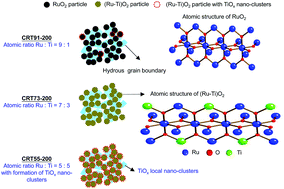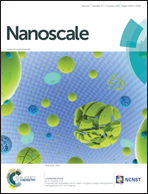Local structure distortion induced by Ti dopants boosting the pseudocapacitance of RuO2-based supercapacitors†
Abstract
Binary oxides with atomic ratios of Ru/Ti = 90/10, 70/30, and 50/50 were fabricated using H2O2-oxidative precipitation with the assistance of a cetyltrimethylammonium bromide (CTAB) template, followed by a thermal treatment at 200 °C. The characteristics of electron structure and local structure extracted from X-ray absorption spectroscopy (XAS) and transmission electron microscopy (TEM) analyses indicate that incorporation of Ti into the RuO2 lattice produces not only the local structural distortion of the RuO6 octahedra in (Ru–Ti)O2 with an increase in the central Ru–Ru distance but also a local crystallization of RuO2. Among the three binary oxides studied, (Ru70–Ti30)O2 exhibits a capacitance improvement of about 1.4-fold relative to the CTAB-modified RuO2, mainly due to the enhanced crystallinity of the distorted RuO6 structure rather than the surface area effect. Upon increasing the extent of Ti doping, the deteriorated supercapacitive performance of (Ru50–Ti50)O2 results from the formation of localized nano-clusters of TiO2 crystallites. These results provide insight into the important role of Ti doping in RuO2 that boosts the pseudocapacitive performance for RuO2-based supercapacitors. The present result is crucial for the design of new binary oxides for supercapacitor applications with extraordinary performance.


 Please wait while we load your content...
Please wait while we load your content...